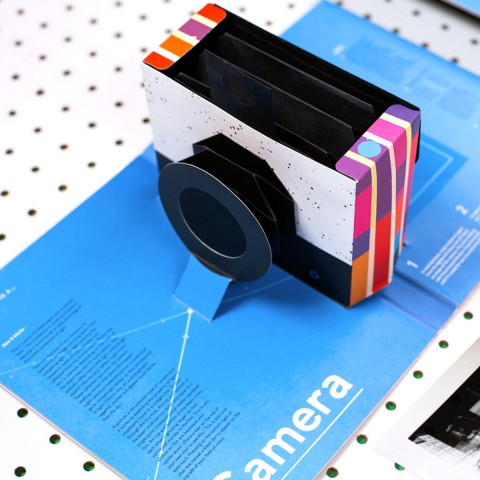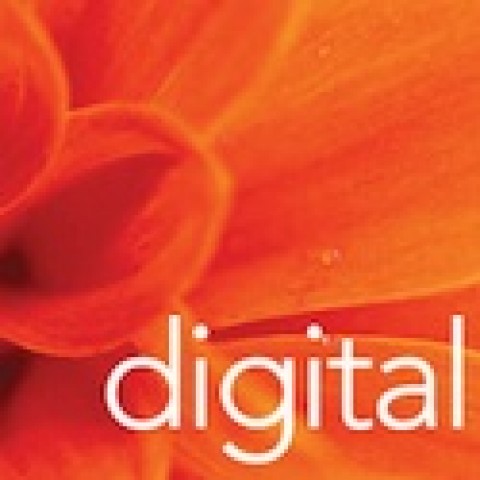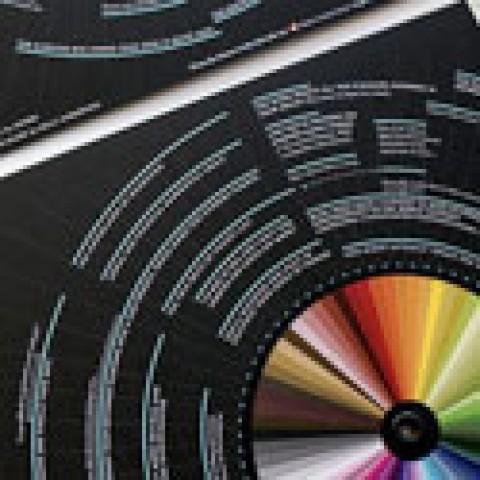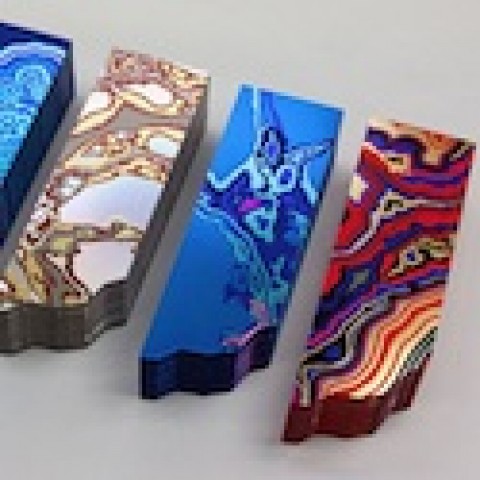“We had so many incredible questions during our Managing Critical Color webinar that we taped an extra segment with our guest speaker Daniel Dejan just to get them all answered,” said Sabine Lenz, CEO of PaperSpecs.
 Dejan, North American ETC Print and Creative Manager for Sappi Fine Paper/North America discussed the in-and-outs of optimizing a color management workflow, showed where most print challenges occur and how to address them to avoid costly pitfalls.
Dejan, North American ETC Print and Creative Manager for Sappi Fine Paper/North America discussed the in-and-outs of optimizing a color management workflow, showed where most print challenges occur and how to address them to avoid costly pitfalls.
Here are his most informative answers and insights to your questions!
When it comes to an uncoated job, how will it appear on a printer’s glossy proof?
Daniel Dejan: I know so many printers when they give you the proof, they’re on a proprietary paper, proprietary to the proofing system that they’re using. I would share that you’re going to be much closer if you ask the printer once they have converted it themselves from RGB to CMYK and they’ve done the voodoo that they know so well, ask them to just print it out on one of their calibrated inkjet printers on an uncoated stock. It will get you very, very close. It will not be such a huge surprise as what happens when you see it on glossy stock and then you go on press and see it on uncoated stock. Obviously, all the colors are going to mute. You’re not going to have the level of color saturation. You’ll have much more dot gain. Hopefully, the printer will have doctored in their plate curves for dot gain. But you’re probably going to be much, much closer if you can get an inkjet proof on uncoated stock. The printer should be able to provide that for you if you ask them.
What is an example on how to calibrate … and then also continue the proper flow, profile, etc. to my printer and also to my scanner?
Daniel Dejan: Very complex question. How to calibrate – not that difficult if you buy a calibration instrument like the X-Rite Eye-One display or the Color Monkey display or a Spyder. All of these come with software – follow the software. It really is a very intuitive process. Once you put in the software, it’s going to show you exactly: “Set your instrument to this setting. Do this. Do this. Put it on the monitor. Hold it there while it does all the things.” That’s pretty straightforward. To answer the question, you have to have a calibration instrument to be able to do it. And then from there, the second part of the question I gave several recommendations of books. If you remember, I suggested the books by Dr. Abhay Sharma. I think they’re exceedingly accessible. They really talk about calibration. There’s a whole chapter on them – terrific. Also, the other book that I recommended very highly – I’m crazy about this book – it’s called CMYK 2.0, and it was written by Rick McCleary. All of these books are available on Amazon or Barnes and Noble or Borders. You can order them online or in some cases, you can even find them at the actual stores. They really will take you through the proper workflow and the process.
What is the importance of profiling?
Daniel Dejan: If you remember when we talked about what is the definition of color management, it is to be able to take a color from an originating device that either has scanned it, captured it or generated the color, and then to be able to take that color information and take it through a workflow that’s going to have a lot of different devices within it. Based on that, the idea being how do I get each of these devices to talk to one another.
The profile, if you remember, has three parts: a) the source profile – originator, c) is the receiving profile or the destination profile, and the b) portion is when we talked about the lookup tables. We said that it is the lookup tables that actually do the work where we can, in fact, see what happens. We talked about the fact that you’ve got an input and an output. What happens is the profiles when they speak to one another, then it accesses the lookup tables in the color management module. The goal is to get each of these devices to use the information. “This is the way I have seen the color or captured it or created it.” The output device is saying “In that case, I need to make these adjustments in order to replicate that color with that same color fidelity.” So profiling is paramount to color management. You cannot have color management without profiling.
What are your thoughts are on the trend to keep RGB native files in the design instead of converting them prior to going to your print provider?
Daniel Dejan: This is probably a conversation that I have with more companies, and I think it’s very, very important. There are so many different schools of thought – there are really several schools of thought and different camps. I am very much of the camp that “I work in RGB. I want to keep that file in RGB for as long as I possibly can.” Why do I want to do that? Because when we go to sample it down, when we rip it, I want to sample from the largest gamut possible. As soon as I convert it to CMYK, I have basically taken all of that information out, and now I am sampling from a very small gamut.
You would be very surprised how many colors can be captured in CMYK from an RGB file. If we can do it, it is available. I keep everything in RGB for as long as possible. I always archive my files as native RGB files because I never know how I’ll repurpose them, and I want to be able to sample from the largest gamut to be able to create in the next project. I feel very strongly. I retouch in RGB. I archive in RGB. In some cases, I actually send the native file to my printer in RGB, and I let them do the CMYK conversion because their equipment is so much better than what we have. We all think because we’ve spent $5,000 or even $10,000 for our hardware and software in our studios that we really are cutting edge. I’ve got to tell you, have you gone into a good printer and looked at their equipment and their software? It’s extraordinary; it really is. When you stop and think about it, they do a lot of work on a Mac, but it really is the Mac talking to the RIP, and that RIP is a quarter-of-a-million or half-a-million dollars. Stay in RGB as long as you possibly can. This is my opinion. If it is a project that is particularly cumbersome to do, send the RGB file to the printer and let them do the conversion. You may end up having to do some retouching at the printer’s once they’ve converted it to CMYK, but I think you’re going to be so much more pleased with the end product.
We talked about several color measuring devices. Steve would like to know which one you would recommend. He has been using Optix XR by X-Rite.
Daniel Dejan: I have to be honest. Any of the X-Rite instruments are absolutely top-notch. A lot of companies are making all kinds of equipment, and certainly, if you go to the color management conference, you’ll see all these different companies who have got superb equipment. I think once you start looking at a company that is making scientific measuring equipment, you’re in a whole different ballpark. You’re paying a different price certainly because it’s going to be more expensive but it has very much to do with a high-end task. You have to realize also there’s a lot of consolidation in the industry. X-Rite ended up buying GretagMacbeth and Pantone. So there aren’t as many companies out there as there used to be, but there are quite a few. There are some Japanese companies that are making beautiful equipment. The investment that you’ve made in the Optix is excellent. Just learn how to use it optimally. In a way, it will serve your purpose perfectly well. The fact that you even made the investment in buying a piece of equipment like that is superb.
I feel very strongly about this. If we are selling color to our customers, we have an obligation to own the tools of the trade and own the tools of color. It means calibrating instruments. It means proper lighting instruments, monitors that are made for critical color. The fact that we don’t do this and I think it really says a lot when I hear about a designer who doesn’t have the equipment and then they blame their printer for not getting what they want. If you’re not going to do your due diligence, then you’re not going to get the result that you expect.
I work on a PC so when I create my images in Photoshop in Adobe ‘98 color space, am I not seeing the full ’98 gamut?”
Daniel Dejan: No, you’re not. Let me put it this way. When we look at the slide, the outside is Adobe 1998. The inside is sRGB. When you’re working on your PC, you really are working on the color space that’s on the inside. What you are setting when you set it to Adobe 1998 is that you are embedding the profile for Adobe 1998 into the file that you are working on, as much as that computer that you’re working on can do it.
Here’s the interesting thing: there are newer models of PCs that are running Microsoft that really have worked hard to expand the gamut. That’s very important. So it can be a larger gamut. If we could and hopefully, one day I’ll try to do for folks is I’ll try to run this again. This software is called ColorThink by CHROMiX. We can actually download the ICC profiles for a wide variety of different CPUs. It would be very interesting, in fact, to put different CPU profiles or color spaces and you could actually see what’s the difference between a Dell, a Gateway. Some of those that are being made really are trying to fill the gap for the content creator in a more corporate setting where you are going to use PCs.
To answer your question, you’re embedding the Adobe 1998 profile into your file rather than the sRGB profile, which is terrific. Keep doing it. But what you’re seeing is really a truncated workspace.
Please let people know that neither operating system is locked into a color profile. Macs aren’t necessarily higher in gamut than Windows machines. Do you want to comment on that?
Daniel Dejan: Well, the fact of it is that a color space that a Mac operating system, particularly the newer ones working it in Adobe 1998 really do generate more colors than a PC working in sRGB.
It is a lot about the embedded profile to maintain the integrity of the workflow. So I think to this point, which I agree, we can work in an Adobe 1998 on a PC and have that be the profile that we are embedding into our file that we are sending on. No, you’re not locked in. But for the most part, keep in my mind that if you’re working on a PC, and you are doing content creation, by default it’s going to be doing it in sRGB unless you have gone in and changed the preferences of your computer.
I just purchased a MacBook Pro for student Photoshop work. Is Adobe 1998 RGB the preferred calibration I should be using?”
Daniel Dejan: It’s not the calibration. We’re not using the right terms. It is the right color space, yes. You would be calibrating that monitor using a tool. So you’re going to characterize it and then calibrate it accordingly. It’s more semantics, and I hate playing semantics. But the fact is you work in 1998 as your color space, yes. And please, please, please calibrate your MacBook Pro because when you pull it out of the box, it is just using default settings from the factory. You can optimize it so that it is much better. It is totally capable of doing so.
Where can I find the lookup table?
Daniel Dejan: You really can’t. The lookup table is part of software; it’s embedded. As an example, when you pick a Pantone color in Illustrator or Photoshop or InDesign, what’s actually happening is that you’re going into the Pantone licensed software. What it’s doing is it’s using a lookup table or color management module and from there, it is determining “I’m choosing PMS 185. What are the RGB builds for PMS 185? What is the corresponding closest CMYK build for that?” That lookup table is actually what does the conversion. You would not see it. You would not find it. It’s built into the software.
As a designer, should I be talking to the printer about CMM and LAB?
Daniel Dejan: If you are working in critical color, if you are working in let’s say a corporate identity color, a bookending color, a very specific product color – yes. You should be articulating that color as a LAB color. It is the most accurate way.
Here’s the interesting thing: all the folks that are in the color world really do work in LAB. What they then do is they take that LAB and they convert it to the specific materials or the specific liquids that are going to be used in order to be able to replicate it. So it can be inks. It can be paint. It can be fingernail polish. It can be car paint. It can be lacquer. It can be whatever. The fact is that we work in LAB and then we convert that into an accepted language for that trade.
Perfect example: probably you’ve all seen the TV commercial where people show up with the most bizarre objects. They show up at the hardware store with a big purple teddy bear, a pair of shoes or whatever and the message is “Yeah, we can match that.” And yes, they can because what they’re going to do is they’re going to take spectrophotomic color test of that. They’re going to get it in LAB and then they are going to convert that, in this case, to wall paint. But we could just as easily take that LAB and turn it into screen printing inks or offset inks or toners or fingernail polish. I hope that makes sense.
Do design schools still teach color theory? Most freelancers we have as clients are clueless about color gamuts, etc.
Daniel Dejan: No. I’ve got to be honest. Most of the schools that I speak to do not teach color theory, unless you go to the print schools – RIT, Ryerson, Clemson, Cal Poly, ASU – those kinds of schools.
It’s interesting that color theory is actually taught more in photography, prepress courses; but as a part of a design curriculum or a communications curriculum, no, not at all. It breaks my heart.
I would share with you a larger concern that I have is that the companies that actually have the most skin in the game, who have the most to benefit are the ones who seem not to be doing as much as they could. That would be companies like Apple, Dell and Microsoft. You don’t see any of the schemes discussed in manuals. Here’s the interesting thing in their defense: they do have resources, and if you go online, you can, in fact, get some good information. I don’t want to make it sound like they’re leaving everybody clueless. But at the same time, very few designers even read manuals, let alone go to Web sites to understand this. It’s a huge challenge and concern. Part of the reason why so many printers appreciate workshops like this (and the color theory workshop we did in Part I) is because it hopefully bridges that gap.
Do XMPie, Dialog and other vendor engines for dynamic print allow for input device to output device profile mapping similar to what Photoshop does?
Daniel Dejan: No, not in the same way. When you talk about XMPie, Dialog – they’re languages. What they’re doing is they are actually converting. You would still have to go in and do the profile or color profile. Photoshop does it as an automatic.
What space do you work on a PC and not a Mac?
Daniel Dejan: The PC is sRGB, and Mac is Adobe 1998. Going back to some of the previous conversations, yes, you can change in your preferences so it is available.
How do you calibrate if you have two different monitors? You have a MacBook and a Wacom 21?
Daniel Dejan: Well, actually you can. You’ve got to optimize both. You’ve got to characterize and calibrate in order to optimize both monitors. But if you use an advanced tool, it will, in fact, let you calibrate the candelas – how bright the monitors are. It will also let you set gamma and a number of different metrics. If you set both monitors once they have been fully calibrated and optimized, you can actually set that they are the same brightness, whiteness, the same levels of RGB in terms of 0 to 255. You can actually get them to be quite similar. But you need a good tool to be able to do that, and you have to have monitors that allow you to go in and change settings like RGB, whiteness, brightness, contrast, gamma, white point, etc. which not a lot of particularly laptops are able to do well. Typically, you would do this more from a tower/CPU and monitor.
I have “Real-World Color Management.” Is the information in the book fully up-to-date considering that it was published in 2005?
Daniel Dejan: It’s still excellent. It’s an excellent book. It’s a heavy read in my opinion. I think some of the newer books really sort of address what’s happening. A lot has happened in five years. I would say the information contained in “Real World Color Management” is excellent, and on a theoretical level – absolutely terrific. In terms of implementation, one of the reasons that I like Rick McCleary’s book and Abhay Sharma’s new book is because they really do address some of the newer innovations and evolutions in technology. It’s good from a theory perspective.
Can you address proofing with Photoshop as far as viewing paper simulation before printing?
Daniel Dejan: Yeah, you can. That all falls under the whole concept of rendering intent. There are a number of different rendering intents. I don’t have that in this particular presentation. I do it when I do live presentations. We talk about rendering intent. It really talks about where is the source and where is it going to. There are really terrific explanations of rendering intent particularly in Abhay Sharma’s book. Basically – and I’m going to do this really quickly – perceptual rendering intent is essentially keeping the fidelity and the integrity of a photographic quality from one working space to another working space. And then we have relative and absolute colorimetric rendering. When we look at relative, what happens is that the paper is not accounted for, whereas in absolute, it is. This is very important. This is particularly what proofers use if they want to be able to simulate the paper.
Again, in relative, the white point in the image is allowed to change to compensate for the paper color. If you’re working on a very creamy paper, it will actually create a very soft yellow (it’s going to lose little bits of yellow and magenta) to kind of simulate the paper. In absolute, no color change to the paper, meaning, the paper is not taken into account.
Most proofing is actually done in relative colorimetry. I have a wonderful slide in my color workshop. You find this in your Photoshop in print. It will ask you if you want to set a rendering intent. You can choose what rendering intent you want. If you want more information, go to Abhay’s book or go to McCleary’s book or any of the color management books or go to Yahoo or Google and type in “rendering intent.”
Does the whole color management thing apply to printing to a digital printer as well as to an offset one?
Daniel Dejan: Absolutely. In fact, right now there’s an enormous amount of attention being focused on digital color management. To me, digital is sort of a complex term. Digital, for me, can either be toner-based or inkjet-based. It can be a desktop printer or a proofer. Frankly, some of the most beautiful proofs that we get are inkjet proofs.
We definitely use color management in digital proofing and printing. The toners are slightly different because the toners are proprietary. Quite honestly, while everybody is trying to get a standard, the reality is there is a bit of a difference between the HP toners versus the Epson toners. Not great, but there are. We’re also working with machines that are not just simple 4-color. Some of them are 6- or 7- or 8-color where they will do two magentas, two cyans, two yellows and a black, or in some cases, two blacks or the ability to add things like orange, green and violet to be able to do like a standard gamut. Yeah, there’s a lot being done right now, and that information is readily available online.
What does SWOP mean?
Daniel Dejan: SWOP is specifications for web offset publications. It is a guideline. It is created by a group called IDEAlliance, which has now teamed up with IPA. These are the folks that actually do the research and work with printers and prepress groups and publishers to be able to create the guidelines for not only a piece of web printing, but more importantly, the way a piece of printing that’s intended to go on the web press should be created. You can get this from our first seminar, but you can also go to IDEAlliance at . You can buy the booklet that gives you all the guidelines.
How can I convince designers to use D50? They do not like the way it looks on their screen. They like things very bright and very blue.
Daniel Dejan: This is going to be a constant challenge. D50 is the standard we use in the United States. Interestingly enough, D65 is used virtually everywhere else in the world. More interestingly, D50 is a lighting standard used by photographers and prepress folks and printers. But in the paper industry, we actually measure paper as D65, and if you want a D50 number, we have to convert it.
The biggest challenge we’re having right now is the market likes bright white, blue white. I don’t think it’s right. I think it makes it much more difficult for color management, absolutely. But the fact is that’s what they prefer. It’s very, very hard.
The best argument is if you want a color critical workflow, then you really have to use D50 because that’s what the photographers are using. That’s the lighting that they’re using when they’re retouching. That’s what the prepress folks are going to use. That is what the printer’s going to use. That’s what you’re going to use when you go into press check. So you might as well stay in the flow. Otherwise, you’re going to be disappointed. You’re going to look at something and go, “Wow, this isn’t as bright as white.” Yeah, absolutely. Keeping the color critical workflow.
Are there companies that can calibrate printers and monitors?
Daniel Dejan: Oh gosh, yeah. There are, in fact, color management consultants all over the United States who will come in and calibrate your monitors, your printers, your scanners, and they do it at an extraordinarily high level. The Color Management Group is a great source for that. They’ll give you names and numbers of folks all over the United States that will do just that.
What I really like is the idea of having somebody come in to ensure not only that all of the monitors are calibrated to the CPUs, but then all the CPUs are then calibrated to the printer that they’re using to output. That, to me, is like paramount.
Do I need to calibrate an Apple cinema display?
Daniel Dejan: Yeah!
Is it limiting then to color manage photos on a PC as opposed to a Mac?
Daniel Dejan: What you want to do is optimize the system that you are on with the understanding the PC is going to have a slightly smaller color space than a Mac. But the fact of it is, you want to optimize it so calibrating is paramount.
What color space would you use to work in Photoshop when designing for web?
Daniel Dejan: sRGB.
Can you describe the practical, pragmatic difference between the Pantone Matching System and the Pantone Goe System?
Daniel Dejan: Just think that it’s got twice as many colors. It’s a different book with a different numbering system. The different numbering system has made it too difficult. You can’t find PMS 185 because it doesn’t exist in the Goe system. Brilliant, brilliant, brilliant color system. The software that comes with the Goe system is just excellent, but you also would get this from the Color Monkey or you can just get this from X-Rite or Pantone.
What degree of Kelvin do you recommend viewing in the live booth?
Daniel Dejan: 5,000 degree Kelvin, which approximates D50.
What does a Color Monkey cost?
Daniel Dejan: Actually, the original retail price manufacturer’s suggested retail price was $500. I have actually seen them anywhere from the high $300s to the low $400s. This is definitely one of the things that if you’re looking for $20, $30, $40 difference, go online and you’ll be amazed, depending on who’s selling it.
We talked about optical or our tendencies to go really bright and blue white in our papers. How does optical brightener in paper affect color management?
Daniel Dejan: Here’s the challenge. It doesn’t show up anywhere really until you actually get to ink on paper. It’s not in proofs. Although we use optical brighteners in the paper that we print through our desktop printers or companies who make proofing stock will add certain amounts of optical brighteners to replicate our premium No. 1 or No. 1 paper, the fact of the matter is, we really don’t see it.
I was using the example of G7 last summer. We were talking about G7 – one of the core principles of G7 is using neutral gray as sort of a benchmark. Neutral gray is either 50 percent white and 50 percent black, or it can be created using 50 percent cyan, 40 percent magenta, 40 percent yellow, and we create what is known as trichromatic gray. The beauty of a trichromatic gray is it’s very balanced. If anyone of those colors goes out, then you’re going to get a blue gray, a pink gray, a green gray, yellow gray, etc. We’ve been working with printers who really have done their due diligence. Their proofs are balanced. You look at the neutral gray bars and they’re uncontaminated, etc. They make their plates on very exacting measure and then they go on press and everything’s balanced. They print those first sheets and they look at the neutral gray and it’s not neutral gray. They see contamination. They see usually something in the pink, purple level. They’re frustrated and they say, “Look, we did everything by the numbers. How can they not be there?” That is where optical brighteners rear their ugly heads. That’s where we’re going to see it. A lot of optical brighteners are really going to make it difficult to have color balance, and you cannot color manage for it, quite frankly. It has to be done on press and you’ve got to be working with a printer who has extensive knowledge in working with certain papers. That’s why you find a printer who likes to work with a certain paper and a certain paper mill because they get to know the idiosyncrasies of that paper and the paper mill – the blue dye content, the optical brightener content – and they’ve learned over time how to compensate for it. That’s the best response I can give to you in a short period of time.
How does one handle color as a production manager in a situation where we are printing a book and the author submits color digital files – so RGB – for art in his book? Once the printer sends color proofs, what is the most accurate way to judge if the color is correct?
Daniel Dejan: Well you know, we are in a very privileged situation because we are the only folks in the entire graphic arts process who actually get to see the original image, see it in RGB, see it converted to CMYK, and see it printed in the ink on paper experience. Nobody else gets to do that. We take that process very, very seriously. That is why most people think that they work in critical color when, in fact, they really don’t. I don’t mean to belittle it.
One of the things that we are paid for is having good color judgment. I would share with you that what’s most important is the product that we send out to our customers. Is it as good as we can make it based on all the science, the technology and the art that we have available to us? So when I say “correct,” it is also subjective.
I may like flesh tones warmer than you. I may like my apples redder. I may like greener grass. Who knows? That’s what you get paid for. If I have an extended experience of doing this for a long time, and people agree with me and people sort of nod to my judgment, it doesn’t make me right. It just says I have a good sense of what the market likes. I would say that that’s very important. Particularly when we look at the United States, I always say in my press check class, you don’t want somebody from Maine press checking your surfing magazine in California – completely different ideas of what flesh tone looks like, in as much as it varies differently when you go from continent to continent.
The Japanese or the Chinese or Indonesians see color very different from the way we see it here in the States. Look at the color proofs. If there is critical color that can be measured using a colorimeter or spectrophotometer, then there’s no question. The numbers are the numbers. But if it’s subjective, then we have to sort of bow to somebody, usually the artist or the generator, whether they like or not, as long as they understand what the limitations are in the printing process.
Considering that most digital cameras shoot in sRGB color space, is all that color information effectively lost if converting to Adobe ’98 RGB in Photoshop after the fact?
Daniel Dejan: First of all, it depends on the digital camera. One of the things that we discuss when I hire a photographer, one of the things I want to do after I look at the aesthetic values of that photographer – do they frame well, do they understand lighting, that kind of stuff – I would ask them if they have a camera or cameras that we can actually set the profile to shoot in. Most of the time, they’d say yes. In most cases, I would say I want to shoot in Adobe 1998 because that’s what I’m going to be working in.
But the answer to the question is if they’re shooting in RGB, they are not capturing the full gamut. Remember when we talked about photo raw as a setting, not a gamut, photo raw is shooting at the largest, widest available gamut possible, much larger than you’re going to possibly use. You want as much detail, as much contrast, as much tonal range as totally possible. And then from there, you’re going to have to assign it a profile. You can say I’m going from raw to sRGB or from raw to Adobe 1998. So have that conversation with the photographer. Don’t necessarily assume you’re shooting in sRGB because that may not be the case.
I work on a PC and when I work in Photoshop, I was told to work space color in Adobe 1998 and to never work in sRGB. Is that correct?
Daniel Dejan: Keep in mind that yes, this was sort of touched on earlier. Printers work in Adobe 1998. One of the challenges that will make a RIP choke or stutter is when we have an embedded profile where you have a sRGB profile embedded into an Adobe 1998 file. What would invariably happen is that the prepress folks will go in and change the profile to 1998 so that you have continuity in the overall files.
What’s very interesting is software like Pit Stop will identify that. As it’s doing its diagnosis, it will say “Oh by the way, here’s this image. It came in as a RGB image or a CMYK image.” But more importantly, it will also say to you “By the way, the profile of this image is a sRGB image in a 1998 file.” The prepress folks will go in advance and modify it to ’98 so that you have a nice continuity that will work optimally. So yeah, you don’t want to have embedded profiles that are not part of the larger color space or working space.
That actually happens a lot particularly with things like catalogs and magazines when you have a lot of different sourcing for imagery. Sometimes, an image comes in and it’s in the camera’s default – an Olympus profile or a Canon profile. Other times, it comes from a corporation where it comes to you as sRGB. What we always recommend is as the images come in, you should have Photoshop set up so that as you download the image, it immediately identifies what profile it is in and then lets you modify it, or automatically. You tell Photoshop, no matter what it is, I want it in 1998, and it will actually go ahead and make those changes automatically.
One of the things that always annoyed me is that you notice that onscreen, color in a PDF looks decidedly different than the same file viewed in Illustrator. Is that actual or just virtual?
Daniel Dejan: In terms of the rendering intent or in terms of “is that real”? One thing to keep in mind is that PDFs by nature are CMYK PDFs. That lets you know that the conversion has been made. Actually, you are seeing different color because once it’s in a PDF format, then it has, in fact, been converted.
The upside of the latest version of PDF is that there are RGB PDFs. It’s a very advanced formatting because the idea “I don’t want it to turn to CMYK. I want to send the printer the RGB information.” It’s a much bigger file; it’s huge. It has kind of a different rendering. Yeah, you are going to see very different physical color between what you’re seeing on your monitor and what happens when you turn it into a PDF. It’s sort of like the analogy that I used about you are on a Mac and you send the file to your customer on a PC. They open it up and a lot of the colors are missing because they just cannot be rendered.
Could you explain briefly what sRGB is?
Daniel Dejan: It is a color space. It is what that particular software is capable of creating. That is, sRGB is in fact the color space or the working space that has been assigned to PCs after the Internet. There’s a much, much better and in-depth explanation in the books that I offered as part of the bibliography.
Let me make this comment. When you hire a color management expert/consultant to come into your company, typically the first thing that they’re going to do is they’re going to create what is known as the color management tree. There are a lot of different terms for it, but it’s easier for us to think of it that way.
What they’re going to do is they’re going to identify all the different ways that color is transferred, converted, all the different devices that are in your workflow. It will be scanners. It will be CPUs. It will be monitors. It will be printers, proofers. What they’ll do is they will create a tree to identify all of these and will give them numbers.
The job is, first of all, to calibrate all the monitors to all the CPUs. Then, it is to be able to calibrate the scanners and optimize them so that they are calibrated and they are calibrated to the CPUs inasmuch as all the desktop printers and proofers are calibrated. They use these RTA color patches with approximately 1,200 different colors on this patch. They’ll scan it. They’ll bring it up. They’ll output it off of a printer and they will do readings using spectrophotometers. Based on that, they can literally see where the color is drifting, being contaminated and make adjustments. So that essentially, if I scan that RTA patch on a scanner and send it to one of my computers and look at it on my monitor that it is exceedingly close. If I take that file from my computer and send it to my printer and when I print it out, all of these 1,200 patches are exceedingly close, in that case, I do have, in fact, a color-managed workflow.
Do you have a white paper on ROI of variable data printing versus static printing?
Daniel Dejan: I don’t, but I would share with you that there’s a wonderful site. It’s the Digital Printing Council, and it is a part of the GATF/PIA. You can go to www.digitalprintingcouncil.com and there’s just an enormous amount of information on digital printing and variable data printing. This group, the Digital Printing Council, if you’re not familiar with them is headed by Frank Romano and the RIT team has expanded over the years. It’s just superb. You’ve got a great Web site and a great resource.
 |
To listen …to view the Managing Critical Color webinar, please click here.
|










